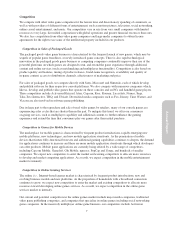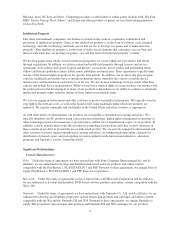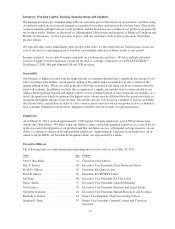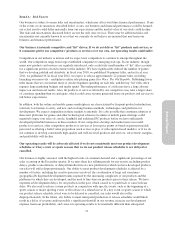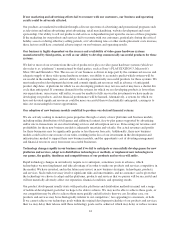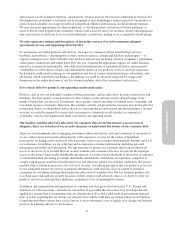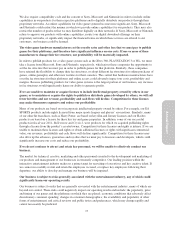Electronic Arts 2011 Annual Report Download - page 92
Download and view the complete annual report
Please find page 92 of the 2011 Electronic Arts annual report below. You can navigate through the pages in the report by either clicking on the pages listed below, or by using the keyword search tool below to find specific information within the annual report.The majority of our sales are made to a relatively small number of key customers. If these customers
reduce their purchases of our products or become unable to pay for them, our business could be harmed.
During the fiscal year ended March 31, 2011, approximately 72 percent of our North America sales were made to
our top ten customers. In Europe, our top ten customers accounted for approximately 46 percent of our sales in
that territory during the fiscal year ended March 31, 2011. Worldwide, we had direct sales to two customers,
GameStop Corp. and Wal-Mart Stores, Inc., which represented approximately 16 percent and 10 percent of total
net revenue, respectively, for the fiscal year ended March 31, 2011. Though our products are available to
consumers through a variety of retailers and directly through us, the concentration of our sales in one, or a few,
large customers could lead to a short-term disruption in our sales if one or more of these customers significantly
reduced their purchases or ceased to carry our products, and could make us more vulnerable to collection risk if
one or more of these large customers became unable to pay for our products or declared bankruptcy.
Additionally, our receivables from these large customers increase significantly in the December quarter as they
make purchases in anticipation of the holiday selling season. Also, having such a large portion of our total net
revenue concentrated in a few customers could reduce our negotiating leverage with these customers. If one or
more of our key customers experience deterioration in their business, or become unable to obtain sufficient
financing to maintain their operations, our business could be harmed.
Our industry is cyclical, driven by the periodic introduction of new video game hardware systems. As we
continue to move through the current cycle, our industry growth may slow down and as a result, our
operating results may be difficult to predict.
Video game hardware systems have historically had a life cycle of four to six years, which causes the video game
software market to be cyclical as well. The current cycle began with Microsoft’s launch of the Xbox 360 in 2005,
and continued in 2006 when Sony and Nintendo launched their next-generation systems, the PLAYSTATION 3
and the Wii, respectively. Sales of software designed for these hardware systems represent the majority of our
revenue, so our growth and success is highly correlated to sales of video game hardware systems. While there are
indications that this current cycle may be extended longer than prior cycles — in part, due to the growth of online
services and content, the greater graphic and processing power of the current generation hardware, and the
introduction of new peripherals — growth in the installed base of the current generation of video game systems is
likely to slow down in the coming years. This slow-down in sales of video game players may cause a
corresponding slow-down in the growth of sales of video game software, which could significantly affect our
operating results.
Sales of used video game products could lower our sales of new video games.
Certain of our retail customers sell used video games. Used video game sales have been growing in North
America, and are emerging in Europe. Used video games are generally priced lower than new video games and
the margins on used games sales are generally greater for retailers than the margins on new game sales. We do
not receive revenue from retailers’ sales of used video games. Sales of used video games may negatively impact
our sales and profitability.
The video game hardware manufacturers are among our chief competitors and frequently control the
manufacturing of and/or access to our video game products. If they do not approve our products, we will
be unable to ship to our customers.
Our agreements with hardware licensors (such as Sony for the PLAYSTATION 3, Microsoft for the Xbox 360,
and Nintendo for the Wii) typically give significant control to the licensor over the approval and manufacturing
of our products, which could, in certain circumstances, leave us unable to get our products approved,
manufactured and shipped to customers. These hardware licensors are also among our chief competitors.
Generally, control of the approval and manufacturing process by the hardware licensors increases both our
manufacturing lead times and costs as compared to those we can achieve independently. While we believe that
our relationships with our hardware licensors are currently good, the potential for these licensors to delay or
refuse to approve or manufacture our products exists. Such occurrences would harm our business and our
financial performance.
16



